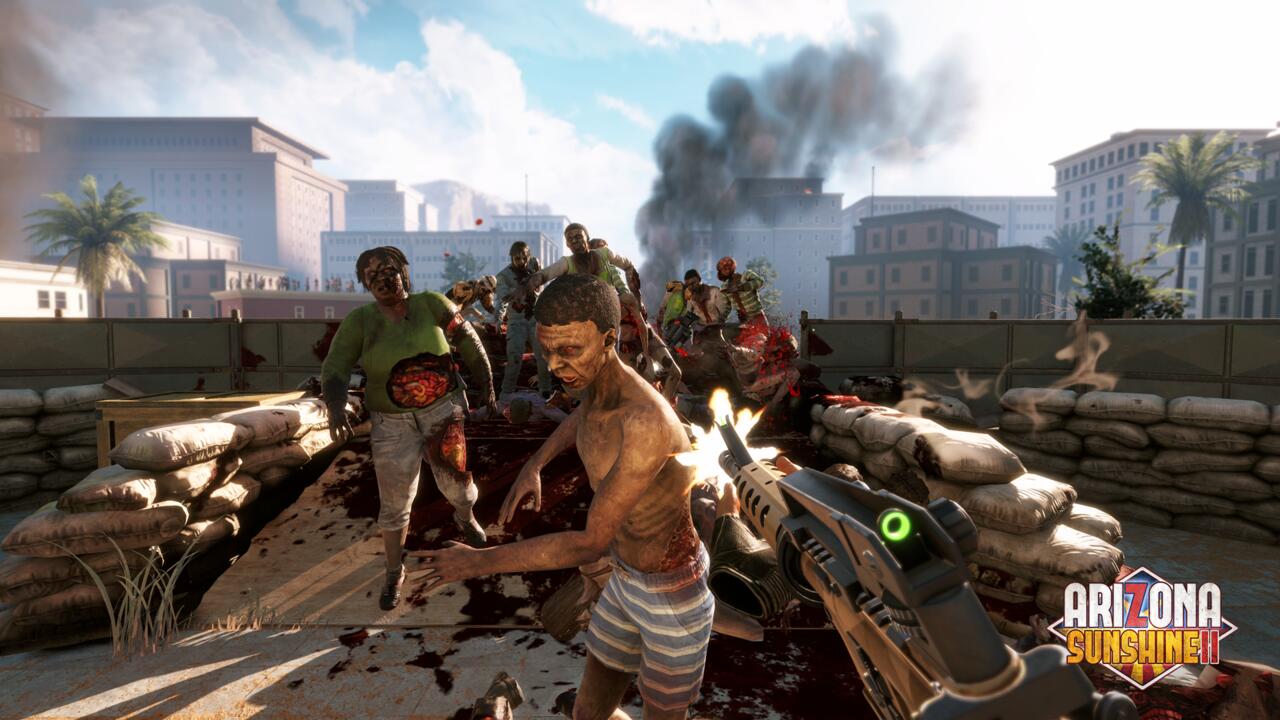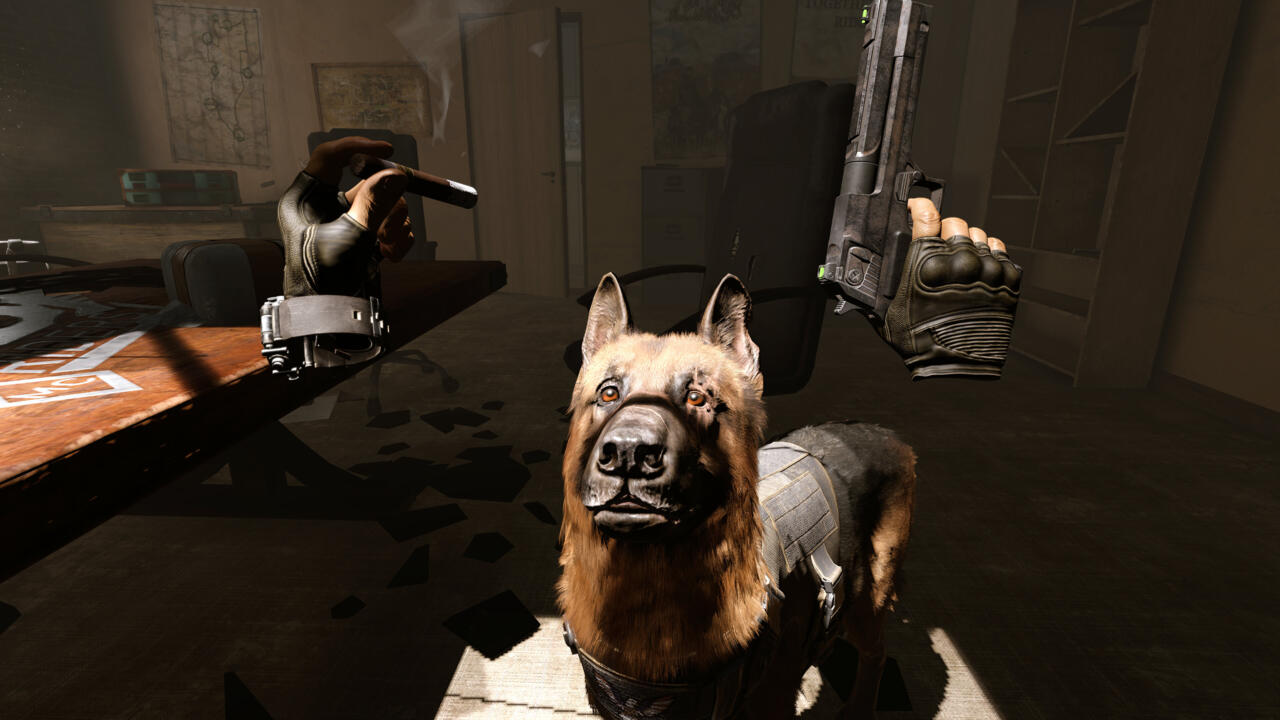Vertigo Games fine-tunes its zombie-slaying power fantasy with more weapons, better set pieces, and man's best friend.
The first time I played Arizona Sunshine 2, I left feeling a bit nauseated, but I soon realized this was due to my time spent away from playing VR games. The second time I played Arizona Sunshine 2, I was quickly overwhelmed by its hordes of undead and left feeling like the game was perhaps unbalanced. By the third time I put on my Quest 3 headset, I’d rediscovered my proverbial sea legs, I’d mastered the art of zombie crowd control, and I enjoyed the game for what it is: an arcadey trek through the apocalypse.
In the VR-exclusive first-person zombie shooter Arizona Sunshine 2, you’ll take on the role of the original game’s hero for another excursion through an undead hellscape of airports, sewage tunnels, and rooftop parking lots, each of them loaded with ammo and “Freds”–the too-jokey protagonist’s word for zombies–in similar quantities. The game’s intentions are clear right away: This isn’t the sort of game where you’ll need to worry about ammo reserves very often. This is a power fantasy, though not without plenty of tension, too.
Arizona Sunshine 2 shines brightest is in those moments when you’re tasked with clearing out intimidatingly large hordes of zombies. As mentioned, at first I found this so difficult that I assumed I failed to account for something–a skill move, or a control option, or something. It turns out I just needed a little practice. Like a lot of VR shooters, you can do yourself huge favors by mastering the reload animation. Initially I fumbled around with that mechanic, which caused me to take more than a few bites to the jugular, but it didn’t take long before I mowed through undead like a John Wick Halloween spin-off.

That’s thanks in large part to the great shooting mechanics. Lining up shots and clearing rooms is a consistent joy because it’s reliable and powerful. Strewn about most levels are different guns with their own firing patterns. At first, I traded one pistol for another slightly different one, or a revolver. But later levels add SMGs, shotguns, and the type of variety you’d expect from a game that hangs its hat (headset?) on dispatching Freds a dozen at a time. On an easier difficulty, the guns come equipped with red dot sights, too, which I actually enjoyed as an added mechanic. I found myself switching between that and normal difficulty just to better appreciate the times I had such an advantage, while still trying to improve my aim without that aid. I found that this practice actually did help me do just that, too, which wound up feeling really satisfying.
But the gunplay was already good in the first game, so what does the sequel add? The answer to that question quickly becomes apparent–and it is two-fold. The more typical addition comes in the form of melee weapons, which are easily breakable but usually serve well as an alternate attack mode for a few mushy craniums at a time before they need to be abandoned. Unlike something like The Walking Dead: Saints & Sinners, which tends to skew toward realism to the extent that your screwdriver can get jammed inside of a zombie’s skull, in AS2, melee attacks are more arcadey, once again fulfilling that power fantasy. Here, beheading zombies feels more like Fruit Ninja than a punishing lesson in sharpness and physics.
But the change that stands tallest actually stands on four legs. Buddy the dog becomes your sidekick for the duration of the game, and the well-trained good boy is a lifesaver–literally–quite often. Getting past those early hordes that gave me trouble basically came down to learning to trust Buddy and sending him leaping for the decaying faces of the zombies heading my way. Buddy’s commands behave almost like a Swiss army knife for the protagonist. You can have him attack zombies, thus slowing them down or even killing them so you don’t have to. He can also fetch items you otherwise couldn’t reach like ammo or keys, and he can also help solve puzzles, usually using a similar fetching mechanic.
These puzzles never go beyond simplistic, but they help fill in the levels with more than shooting galleries, breaking up the pacing and giving me much-needed breathers every so often. It was through Buddy that I learned how to tame a horde and enter my John Wick flow state, sending him to the left while I’d headshot a few zombies on the right, chop off a few limbs with satisfying direction-based melee combat, and move through the now opened path. I’d then turn around in the doorway upon my exit to immobilize the remaining few while Buddy would bark and return to me like he deserved a treat–and clearly he did, based on the scene we’d left in our wake.

The inclusion of Buddy means more complicated attack patterns with more classes of zombies are possible, and that variety becomes a strength of the game, especially when paired with the ample set-pieces that tended to limit my freedom of movement in order to sell a key moment of the action, like driving across an airport on a lift, or performing something akin to a concert for fans who, despite their undeath, seemed quite lively in the moment.
Even with plenty of ammo, rock-solid shooting mechanics, and the help of Buddy, these scenes managed to be tense because once a zombie does get in your face, it can be very hard to overcome. I found myself counting bullets as I fired them off so I always knew when to reload, which fulfills the sort of zombie fantasy I look for in every game featuring the undead.
If ever this setup isn’t enough, you can once again play the entire story mode in online co-op with one other player. Nothing fundamentally changes, for better or worse, though it does benefit from my general belief that most everything in games is better in co-op. There are exceptions, but AS2 isn’t one of them. The arcade-like shooter is a natural fit for a friend, even as the game already provides one on four legs. The only issue co-op creates is a narrative one; you’re the “sole survivor” according to the plot, which is already rudely dismissive of Buddy’s existence, but this moniker is further nonsensical when you consider the co-op pal that can accompany you.
Still, this isn’t likely a game most play for the story, which is a good thing since the story is its weakest aspect by far. Like in the first game, the protagonist is a wise-cracking, foul-mouthed dude whose entire personality is revealed by way of bad jokes that annoyed me throughout the game. That problem is exacerbated by just how frequently he speaks. AS2 is a game that suffers from the very video-gamey thing of having a character talk to themselves far too often as a way to guide the player. If he either spoke less or didn’t make me cringe, I’d have found this less distracting, but these issues as a pair soured some of the good times I was otherwise having. The story is also devoid of any surprises. I mentally jotted down where I thought the story would go from the first level, and it essentially played out just as I expected. Given the game wants to be an adventure more than an actual shooting gallery, the lack of stakes and stunning moments winds up dampening the levels in a way the gameplay never does.
Arizona Sunshine 2 is not the mythical killer app that will finally get people to believe in VR. But it’s certainly the kind of sequel that goes bigger than its predecessor and is better for it. It almost feels like a tall order to ask people to still care about zombies and VR in 2023 when so many seem to have shrugged them both off years ago. But I’m not such a person, and if you’re like me, you’ll find Arizona Sunshine 2 is an enjoyable, albeit predictable, road trip through the apocalypse.






